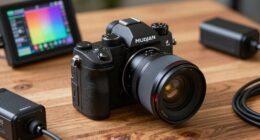To choose the right printer for home use, first consider your main printing needs—are you mainly printing documents or photos? Think about space, whether you need a compact, portable device or a larger, high-capacity model. Decide if you want a single-function or an all-in-one printer for extra features like scanning and copying. Also, weigh ongoing costs, such as ink or toner supplies. Continue exploring to find the perfect device that matches your home setup and habits.
Key Takeaways
- Determine your primary printing needs, such as text documents, photos, or a mix, to choose between laser and inkjet printers.
- Decide if a single-function printer or an all-in-one device suits your home tasks like scanning or copying.
- Consider space, mobility, and connectivity options like Wi-Fi, mobile printing, or wired connections for convenience.
- Evaluate ongoing costs, including ink or toner refill expenses, and select printers with efficient, affordable supplies.
- Check for additional features like high paper capacity, energy efficiency, and support services based on your specific requirements.

Are you overwhelmed by the variety of printers available and unsure which one suits your needs? You’re not alone. Choosing the right printer for home use can seem intimidating with so many options to consider. The first step is to think about what you’ll mainly use it for. If you print mostly text documents, a laser printer might be your best choice because it’s faster and more cost-effective per page. Laser printers use toner, which lasts longer and can handle high volumes without frequent refills. On the other hand, if you love printing photos or detailed color images, an inkjet printer is likely better. Inkjet models excel at producing vibrant, high-quality photos, especially those with dedicated photo printing capabilities.
Choosing between laser and inkjet printers depends on your printing needs and priorities.
Next, consider whether you need a multifunction device or just a basic printer. All-in-one printers combine printing, scanning, copying, and sometimes faxing, making them ideal if you want versatility in a single device. They’re perfect for small home offices or for those who occasionally need to digitize documents. But if your primary concern is just printing, a single-function printer will usually cost less upfront and operate more efficiently. When it comes to ink, EcoTank printers with refillable ink tanks can save you money in the long run, as they reduce the cost per page compared to traditional cartridges. If you’re on a tight budget initially, basic models with standard ink cartridges are more affordable, but keep in mind that refill costs can add up over time.
Your space and mobility needs also matter. Portable printers are compact and battery-powered, making them suitable for travel or occasional use away from your desk. Desktop printers tend to be larger but often offer more features, like higher paper capacity or better connectivity options. Speaking of connectivity, wireless printers provide the flexibility to print from multiple devices without cables. Features like Wi-Fi Direct, mobile apps, NFC, and cloud printing can make your printing experience more convenient, especially if you share the printer among family members. If you prefer a stable, reliable connection and don’t mind wired setups, a USB or Ethernet-connected printer can be a good option.
Additionally, consider the cost of supplies, such as ink and toner, which can significantly impact your ongoing expenses. Finally, think about the ongoing costs and maintenance. Check the cost of replacement ink or toner and how easy it is to find supplies. Look for models with energy-efficient features, and consider the warranty and customer support options. Regular cleaning and alignment are necessary to keep your printer running smoothly, so choose a brand known for good support. By focusing on your specific needs—whether photo quality, speed, cost, or connectivity—you can find a printer that fits your home perfectly, saving you time, money, and frustration down the line.
Frequently Asked Questions
What Is the Average Lifespan of a Home Printer?
You’re wondering about the average lifespan of a home printer. Typically, an inkjet printer lasts around three years, while a laser printer can serve you for about five years. Factors like usage level, maintenance, and environment influence these numbers. By taking good care of your printer, performing regular cleaning, and avoiding excessive use, you can maximize its lifespan and get the most value from your investment.
How Much Does It Cost to Maintain a Home Printer Annually?
You might think a home printer is cheap to maintain, but annual costs can surprise you. Expect to spend around $200 to $800 on service contracts, plus roughly $270 on ink and toner. Parts like drums and rollers can add more, especially for laser models. Regular maintenance helps, but without it, repairs and replacements can drive costs up. Budgeting for these expenses guarantees your printer stays reliable and affordable over time.
Are Wireless Printers More Reliable Than Wired Ones?
Wireless printers aren’t more reliable than wired ones. You might face signal drops, interference from other devices, or slower speeds, especially during high network traffic. Wired printers, on the other hand, provide a stable, consistent connection, with fewer disruptions. If reliability is your priority, a wired setup guarantees smoother printing without the worry of signal issues or interruptions, making it a better choice for consistent performance.
Can a Printer Handle High-Volume Printing at Home?
Did you know laser printers can print up to 55 pages per minute? When it comes to handling high-volume printing at home, look for a printer with a large paper tray, high-capacity toner or ink, and fast print speeds. Choose one with automatic feeders, wireless connectivity, and energy efficiency. These features guarantee you can print large volumes efficiently, reliably, and without constant refills or excessive costs.
What Are the Best Brands for Budget-Friendly Home Printers?
You want to find budget-friendly home printers, so consider brands like Brother, Canon, Epson, and HP. Brother offers affordable all-in-one models with good print quality, while Canon provides wireless printers at a low cost. Epson’s EcoTank series saves money with refillable ink tanks, and HP’s compact printers like the Envy Pro 6420 combine affordability with versatile features. These brands give you reliable options without breaking the bank.
Conclusion
Choosing the right printer is like finding the key to unleash your creative world. When you select wisely, you’re opening a door to endless possibilities, making everyday tasks smoother and more enjoyable. Remember, your printer isn’t just a machine—it’s a bridge to your ideas, a canvas for your dreams. So, pick one that fits your needs, and let it be the steady hand guiding your journey from imagination to reality.










